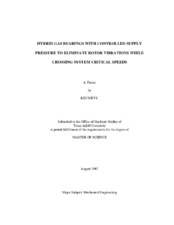| dc.description.abstract | Micro-turbomachinery (MTM) implements gas bearings in compact units of enhanced mechanical reliability. Gas bearings, however, have little damping and are prone to wear during frequent rotor start-up and shut down conditions. Externally pressurized gas bearings provide a simple solution to overcome excessive drag and allowing rub-free operation during transient response events. Some commercial MTM currently implements gas foil bearings, a costly proprietary technology with few, if any, proven reliable predictive design models. The thrust of this research is to investigate conventional bearings of low cost, easy to manufacture (common materials) and easy to install and align. Flexure pivot tilting pad bearings offer little or no cross-coupled stiffnesses with enhanced rotordynamic stability. These bearings, modified for hydrostatic pressurization, demonstrated superior rotordynamic performance over other simple gas bearing configurations. The test rig comprises of a rigid rotor, 0.825 kg and 28.6 mm in diameter, supported on two hybrid flexure pivot hybrid gas bearings, each with four pads and 60% pivot offset and 0.6 mm feeding holes. Experimental results show that external pressurization stiffens the gas bearings, increasing the system critical speed while reducing the modal damping. Most importantly, the tests demonstrate that external pressurization is not needed for super critical speed operation. In practice, the supply pressure could be shut off at high speeds with substantial savings in operational efficiency. In addition, controlling the feed pressure while the rotor passes through its critical speeds can eliminate high amplitude motions because of the bearings’ inherent little damping. In 2007, the test rig integrates an inexpensive automatic air pressure regulator to control the supply pressure into the gas bearings. The measured system dynamic response determines the regulator control scheme with a programmed schedule over a rotor speed region enclosing the system critical speeds. Rotor speed coast-down tests with controlled supply pressure into the bearings demonstrate the effective elimination of large rotor motion amplitudes while crossing the system critical speeds. The simple on-off supply pressure control, i.e. a sudden increase in pressure while approaching a critical speed, is the best since it changes abruptly the bearing stiffness coefficients and moves the system critical speed to a higher speed. A rotordynamic analysis, integrating bearing force coefficients predicted by an existing TRC computational model, forwards critical speeds in agreement with the test results. Predicted rotor synchronous responses for the cases with controlled supply show an excellent correlation with the measured responses. The experiments validate the predictive tools and demonstrate the controllable rotordynamic characteristics of the flexure pivot hybrid gas bearings. | en |


